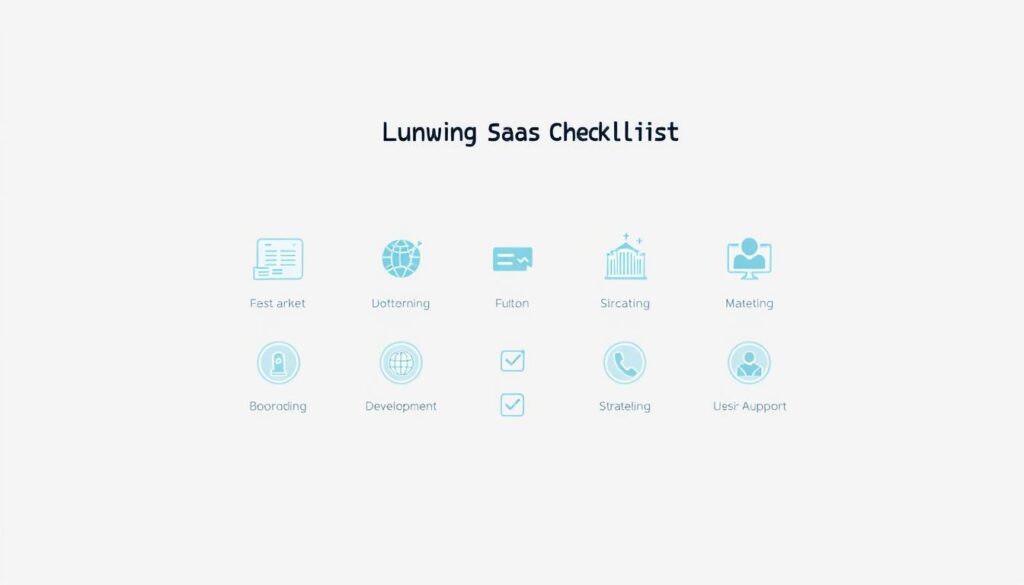Did you know 80% of SaaS companies fail to meet their goals? This is because they don’t do enough market research before launching. In this guide, we’ll show you how to go from unknown to market leader.
The SaaS industry is growing fast, with a market value expected to hit $600 billion by 2025. This growth brings both chances and challenges for new players. We’ll cover key strategies and best practices to help you succeed in the tech marketplace.
Launching a SaaS product is more than just a good idea. It’s about knowing your market, creating a strong value proposition, and using the right platforms to find your audience. With profit margins between 70% and 90%, the rewards are big for those who get it right.
Key Takeaways
- Thorough market research is crucial for SaaS success
- The SaaS market is projected to reach $600 billion by 2025
- Profit margins for SaaS businesses can range from 70% to 90%
- 75% of customers prefer monthly subscription payments
- Developing a minimum viable product (MVP) typically takes 3 to 6 months
- Iterative development can increase efficiency by up to 50%
- Automated customer support can reduce costs by up to 30%
Understanding the SaaS Marketplace Landscape in 2024

The SaaS marketplace is booming, with over 25,000 companies worldwide and 17,000 in the U.S. alone. This rapid growth has transformed the software industry. It’s now crucial for businesses to craft a solid go-to-market strategy.
Current Market Size and Growth Projections
The SaaS market has seen explosive growth, expanding from $31.5 billion in 2015 to $171.9 billion in 2022. This five-fold increase highlights the growing demand for cloud-based solutions. Projections indicate continued expansion, with B2C online marketplace sales in the U.S. expected to hit $2.1 trillion by 2024.
Key Technology Marketplace Players
Leading the pack are giants like Salesforce, used by over 150,000 businesses for customer relationship management. HubSpot serves more than 113,925 customers across 120+ countries, showcasing the global reach of SaaS platforms. These success stories underscore the importance of effective software listing and monetization strategies.
Market Trends and Opportunities
The marketplace model is gaining traction due to competitive pricing and product variety. Approximately 99% of firms and 78% of small businesses use at least one SaaS tool, indicating a vast market for new entrants. Key trends include:
- User-friendly design for improved navigation
- Enhanced security measures for transactions
- Scalable platforms to accommodate growth
- Legal compliance and transparent policies
These trends present significant opportunities for SaaS providers to refine their software monetization strategies. They can capture market share in this dynamic landscape.
Essential Preparations Before Your SaaS Launch

Launching a SaaS product needs careful planning and execution. The global SaaS market is expected to hit $623 billion by 2025. So, having good software marketing and online distribution plans is key to success.
Start by thoroughly testing your product. A bad launch can lead to negative reviews and high churn rates. In fact, 92% of SaaS startups fail within 3 years, often because their product doesn’t fit the market.
Then, work on pre-sales experiments. Many founders skip this step, but it’s crucial for checking demand. Talk to at least ten potential users before you launch. This can help you get revenue and create a waiting list, which might even fund your development.
- Develop a solid infrastructure
- Create a pre-launch marketing strategy
- Set up customer support systems
Make sure your onboarding process is easy for users. Companies like Autodesk have seen success by offering lots of learning resources. Think about adding features like process completion bars during sign-up to improve the user experience.
Remember, 9 out of 10 SaaS startups become unprofitable due to building products that are hard to sell. Don’t assume marketing will compensate for poor product fit.
By focusing on these preparations, you’ll be ready to make a strong impact in the tech market. Remember, good software marketing and online distribution are essential to stand out in this competitive field.
From Zero to Hero: Launching Your SaaS on a Technology Marketplace

Launching your SaaS on a tech marketplace can change your business game. With the right plan, you can quickly rise from zero to hero. Let’s look at the main steps for a successful launch.
Pre-launch Checklist
Before you launch, make sure you have a detailed checklist. This covers all important steps for your cloud software. Key items include:
- Finalizing your software pricing models
- Setting up customer support channels
- Preparing marketing materials
- Testing your product thoroughly
Launch Day Strategy
On launch day, focus on getting noticed and gaining traction. Use the marketplace’s tools to your advantage. For example, Markko’s platform offers customization and scalability for your audience. Consider these tactics:
- Leverage in-app messaging for user engagement
- Use built-in SEO tools to boost visibility
- Activate multi-language support for global reach
Post-launch Monitoring
After launching, keep a close eye on your product’s performance. Use the marketplace’s analytics to understand your product better. Focus on:
- User engagement metrics
- Customer feedback and ratings
- Sales performance across different pricing tiers
Launching on a marketplace like Markko can speed up your time to market. With the right strategy, you can launch your SaaS in weeks, not months. This sets the stage for quick growth and success.
Building a Compelling Product Story and Value Proposition
In today’s competitive world, telling a strong story for your SaaS launch is key. A good story can make your product shine and connect with potential buyers.
Crafting Your Unique Selling Points
Find out what makes your SaaS unique. Talk about the problems it solves and how it makes users’ lives better. A clear Unique Value Proposition (UVP) can increase sales by 20% and loyalty by 41%.
Developing Brand Messaging
Create a story that matches your audience’s values. Research shows 62% of people prefer brands that share their beliefs. Make sure your messages talk about your product’s story, mission, and impact.
Creating Marketing Collateral
Make materials that clearly show your product’s benefits. Use storytelling in your marketing. Companies that tell great stories see a 20% sales boost.
“A brand is no longer what we tell the consumer it is – it is what consumers tell each other it is.” – Scott Cook, co-founder of Intuit
Remember, 80% of customers value authenticity. A real, engaging story can create a strong bond with your audience. This drives engagement and boosts your SaaS launch success.
Pricing Strategies for Technology Marketplaces
Choosing the right software pricing models is key for making money in tech marketplaces. A good pricing plan can increase sales, keep customers coming back, and grow your market share.
Value-based pricing is a strong choice. It’s about how much customers are willing to pay for what they get. SaaS companies using this method often see better profits than those using other pricing methods.
Penetration pricing is great for new companies. By starting with low prices, you can quickly win over customers. Then, as people get to know your brand, you can raise prices.
- Freemium model: Offer basic features for free, charge for premium options
- Tiered pricing: Create different price points for varying feature sets
- Usage-based pricing: Charge based on actual product usage
Being clear about your prices is important. SaaS companies that show their prices on their websites get more leads and demo bookings. This builds trust and helps customers make better choices.
“Effective pricing isn’t just about numbers. It’s about communicating value and building long-term relationships with customers.”
Keep in mind, your pricing should match what your target market expects and what makes your product special. It’s also important to regularly check and change your pricing to keep doing well in software monetization.
Optimizing Your SaaS Product Listing
In the competitive world of online software distribution, your product listing is key. A well-crafted listing can attract potential customers and boost conversions. Let’s look at some strategies to make your SaaS product listing stand out.
SEO Best Practices for Marketplace Listings
To improve your visibility in tech marketplaces, follow these SEO tips:
- Use relevant keywords in your title and description
- Create unique, compelling content that showcases your product’s value
- Optimize meta descriptions and tags for better search engine performance
Visual Content Guidelines
Visual elements are crucial in attracting customers. Here are some guidelines:
- Use high-quality screenshots to show your product’s interface
- Create an eye-catching logo that represents your brand
- Include short demo videos to show off key features
Product Description Optimization
Write a compelling product description that speaks to your target audience:
- Clearly state your unique selling points
- Address common pain points your software solves
- Use bullet points to highlight key features and benefits
Remember, a well-optimized product listing can greatly impact your success. By using these strategies, you’ll attract and convert more customers in the competitive SaaS marketplace.
Customer Acquisition and Onboarding Strategies
Getting new customers and onboarding them well is key for any SaaS launch. A good go-to-market plan can really help your SaaS grow. Let’s look at ways to increase your user base and keep them coming back.
Content marketing is very important for SaaS. A DemandGen Report found that 67% of B2B buyers use content more when buying. Making valuable content can draw in customers and show your brand’s expertise.
Using a freemium model can work well. Companies like Slack turned free users into paying ones by adding more features. This lets users see the product’s value before buying.
It’s also key to set the right price. Good pricing can boost SaaS revenue by 5-10% in the first year. Think about tiered pricing, which lets businesses grow with their spending.
A smooth onboarding process is vital for keeping customers. Personalized onboarding can cut onboarding time by up to 50%, leading to faster adoption. Try a “choose your own adventure” onboarding to make it more personal and engaging.
- Offer educational resources during onboarding to increase customer engagement
- Implement a “pause subscription” option to help reduce churn rates
- Create a “customer advisory board” to foster long-term collaboration
- Provide “on-demand” live demos for personalized sales experiences
By focusing on these strategies, you can make your SaaS launch more successful. This will lay a strong foundation for growth in the competitive SaaS market.
Monetization and Revenue Growth Tactics
Mastering software monetization is crucial for success in the SaaS market. Companies use various revenue models and strategies to grow. Let’s look at some ways to increase your profits.
Revenue Models
Cloud software deployment allows for different pricing. Many SaaS companies offer basic, pro, and enterprise plans. This lets customers pick what fits their budget and needs.
Some businesses succeed with a freemium model. They offer a basic version for free and charge for extra features.
Upselling Strategies
Upselling can greatly increase customer value. Offering feature upgrades or more user licenses as needs grow is effective. A strong go-to-market strategy helps find upselling chances and boosts earnings.
Customer Retention Techniques
Keeping customers is key for long-term success. Here are some effective ways:
- Provide excellent customer support
- Regularly update and improve your product
- Offer loyalty rewards or discounts for long-term subscribers
- Implement a referral program to encourage word-of-mouth marketing
By using these tactics, you can create a steady income stream for your SaaS product. This is important in the competitive tech market.
Scaling Your SaaS Presence Across Multiple Marketplaces
The SaaS industry is booming, and growing your presence in many technology marketplaces is key. By 2032, SaaS companies could make $1,228.87 billion. This growth is a big chance for cloud software to grow and expand.
Using a multi-marketplace strategy can really help you reach more people. Here are some important things to think about:
- Market diversity: Each technology marketplace has its own users
- Localization: Make your product fit for different places and languages
- Compliance: Follow the rules of each marketplace
It’s important to keep your brand consistent but also adapt to each marketplace. Use data from different platforms to improve your product and marketing. This fits with the trend of micro SaaS tools, which focus on specific markets and industries.
“By the end of 2025, 85% of companies are projected to be utilizing at least one SaaS solution.”
To grow well, try these strategies:
- Make your product modular for easy changes
- Have a central place for customer support
- Use automated cloud software deployment
- Work with local resellers in new markets
By growing your SaaS in many technology marketplaces, you can reach new customers and make more money. This growth is crucial for success in the changing SaaS world.
Conclusion: Keys to Sustainable Success in the SaaS Marketplace
Launching your SaaS on a tech marketplace can change your game. It’s a journey that needs careful planning, smart execution, and constant change. A successful launch depends on knowing market trends, creating a strong value proposition, and making your product listing stand out.
The SaaS world is changing fast, with a 30% growth expected in the next five years. This growth comes from more demand for flexible, scalable solutions in various industries. Understanding human behavior and interaction can make your product more appealing and engaging to customers.
Success in the SaaS market isn’t just about the launch. It’s about building a lasting business that puts customers first. Companies that care about sustainability and social responsibility see a 46% boost in customer loyalty. By innovating, listening to feedback, and keeping up with trends, your SaaS can stay valuable and relevant.
In short, starting your SaaS on a tech marketplace is just the start. With the right strategies, a focus on customers, and a commitment to growth, you can turn your SaaS into a leader. You’ll go from unknown to hero in the fast-paced world of tech marketplaces.

